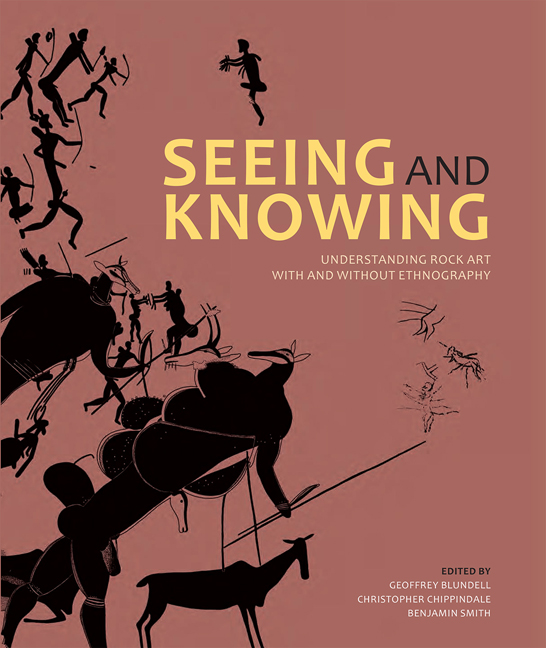Book contents
- Frontmatter
- Dedication
- Contents
- Contributors
- Acronyms
- Chapter 1 Rock art with and without ethnography
- Chapter 2 Flashes of brilliance: San rock paintings of heaven's things
- Chapter 3 Snake and veil: The rock engravings of Driekopseiland, Northern Cape South Africa
- Chapter 4 Cups and saucers: A preliminary investigation of the rock carvings of Tsodilo Hills, northern Botswana
- Chapter 5 Art and authorship in southern African rock art: Examining the Limpopo-Shashe Confluence Area
- Chapter 6 Archaeology, ethnography, and rock art: A modern-day study from Tanzania
- Chapter 7 Art and belief: The ever-changing and the never-changing in the Far west
- Chapter 8 Crow Indian elk love-medicine and rock art in Montana and Wyoming
- Chapter 9 Layer by layer: Precision and accuracy in rock art recording and dating
- Chapter 10 From the tyranny of the figures to the interrelationship between myths, rock art and their surfaces
- Chapter 11 Composite creatures in European Palaeolithic art
- Chapter 12 Thinking strings: On theory, shifts and conceptual issues in the study of Palaeolithic art
- Chapter 13 Rock art without ethnography? A history of attitude to rock art and landscape at Frøysjøen, western norway
- Chapter 14 ‘Meaning cannot rest or stay the same’
- Chapter 15 Manica rock art in contemporary society
- Chapter 16 Oral tradition, ethnography, and the practice of north American archaeology
- Chapter 17 Beyond rock art: Archaeological interpretation and the shamanic frame
- List of figures
- List of tables
- List of publications by david Lewis-williams
- Index
Chapter 12 - Thinking strings: On theory, shifts and conceptual issues in the study of Palaeolithic art
Published online by Cambridge University Press: 21 April 2018
- Frontmatter
- Dedication
- Contents
- Contributors
- Acronyms
- Chapter 1 Rock art with and without ethnography
- Chapter 2 Flashes of brilliance: San rock paintings of heaven's things
- Chapter 3 Snake and veil: The rock engravings of Driekopseiland, Northern Cape South Africa
- Chapter 4 Cups and saucers: A preliminary investigation of the rock carvings of Tsodilo Hills, northern Botswana
- Chapter 5 Art and authorship in southern African rock art: Examining the Limpopo-Shashe Confluence Area
- Chapter 6 Archaeology, ethnography, and rock art: A modern-day study from Tanzania
- Chapter 7 Art and belief: The ever-changing and the never-changing in the Far west
- Chapter 8 Crow Indian elk love-medicine and rock art in Montana and Wyoming
- Chapter 9 Layer by layer: Precision and accuracy in rock art recording and dating
- Chapter 10 From the tyranny of the figures to the interrelationship between myths, rock art and their surfaces
- Chapter 11 Composite creatures in European Palaeolithic art
- Chapter 12 Thinking strings: On theory, shifts and conceptual issues in the study of Palaeolithic art
- Chapter 13 Rock art without ethnography? A history of attitude to rock art and landscape at Frøysjøen, western norway
- Chapter 14 ‘Meaning cannot rest or stay the same’
- Chapter 15 Manica rock art in contemporary society
- Chapter 16 Oral tradition, ethnography, and the practice of north American archaeology
- Chapter 17 Beyond rock art: Archaeological interpretation and the shamanic frame
- List of figures
- List of tables
- List of publications by david Lewis-williams
- Index
Summary
AFTER A FOUNDING TEXT
In a 1985 article entitled ‘Present and Future Directions in the Study of Rock Art’, art historian Whitney Davis noted, among other things, that Lewis-Williams’ 1981 classic, Believing and Seeing, was likely to become regarded as a ‘founding text’ in what Davis (1985: 5) predicted would be a rock art research that “will advance, after many decades of relative neglect, to the forefront of anthropological and art historical theory.” Although Lewis-Williams (1995a) has distanced himself from this founding text, each of us has many observations on his role in and contributions to the achievement of what Davis predicted more than 20 years ago. There are two not unrelated aspects of Lewis-Williams’ enormous corpus that are of particular interest and inspiration to me, as someone who has long focused on the ‘art’ of the Palaeolithic European world.
On the one hand, there has been his attention to and always eloquent articulation of the issues of theory and epistemology that have provided the veritable bedrock on which ‘advance to the forefront’ could take place; on the other hand, his engagement – albeit varying – with ‘the social’ has been a pervasive theme (e.g. Lewis-Williams 1982, 1995a, 1995b, 2000). Furthermore, he sets a model for a self-reflexive commentary on one's own historical intellectual trajectory, which includes (e.g. Lewis-Williams 1995a) recognition of his experimentation over the years with a variety of approaches, from very early structuralist, through somewhat marxist (with a lower-case ‘m’) – perhaps more accurately, historical materialist (Lewis- Williams 1982) – to more recent recognition and use (Lewis-Williams 1995a, 1997) of social theory that draws on aspects of agency and praxis.
My original intent in this chapter was to assess the state of social archaeology today, especially in relation to my usual topic of the Palaeolithic of Europe, combining two strands of Lewis-Williams’ influence: the explicit engagement with theory and an explicit concern for ‘the social’. In some ways, these concerns do not neatly fit the two thematic emphases of this volume, which elaborates on the two approaches to rock art set out by Taçon and Chippindale (1998; see also Chippindale 2001): informed contexts (e.g. the use of and relation to ethnography) and formal methods (for situations lacking direct or relevant ethnographic contexts).
- Type
- Chapter
- Information
- Seeing and KnowingUnderstanding Rock Art With and Without Ethnography, pp. 198 - 213Publisher: Wits University PressPrint publication year: 2010



